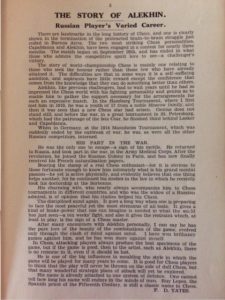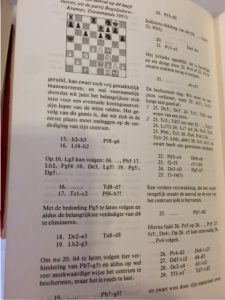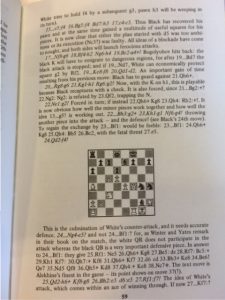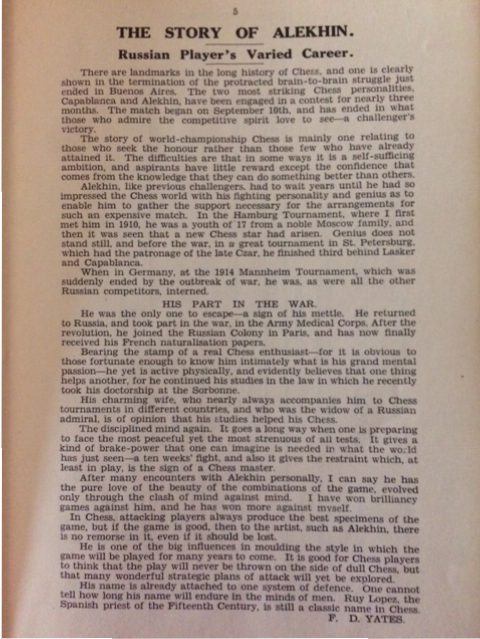The book that got me into Alekhine – Bogolyubow was a book of the match by Yates and Winter that appeared in 1930. If truth be told, I have a few doubts about the scale of Yates’ contribution to the book. Winter wrote a short biography of Bogolyubow and also the theoretical review of the match. Yates wrote the introductory text about Alekhine, but it read a little strangely as if it had been written just after Alekhine’s victorious match against Capablanca:

Bizarrely enough, that is the case! Looking through the British Newspaper Archives, I found an article by Yates in the Yorkshire Post of 29th November 1927 that is word-for-word the same article!
Anyway, back to the chess! Alekhine restarted the match in very controlled fashion with Black winning 2 smooth games in the 10th and 12th games. Unexpectedly however, he then lost the 13th and 14th games in poor style. Just take a look at the positions he lost:
Alekhine,Alexander – Bogoljubow,Efim
World Championship 13th Match Game 1929
Black is a little better due to White’s queenside weaknesses (in particular the pawn on a3) but it’s a bit shocking for Alekhine to be completely lost within 4 moves!
28.Re1 Bxd5 29.exd5 Qd3 30.Rxc8 Rxc8 31.Bxa4 Qe4
A very evil tactic!
32.Qd2 Qxa4 33.d6 Qd4 34.Qxd4 exd4
0–1
The 14th game was maybe even worse as Alekhine contrived to lose this position as Black:
I think that these games say a lot about Alekhine’s mindset for the 1929 match and the difference with his match against Capablanca. Against Capablanca, every full point was like gold dust and Alekhine scrapped to the death to save inferior positions.
Against Bogolyubow, I have the feeling that Alekhine had the same attitude as the Brazilian football teams of the 70’s: “You score 4 goals, we’ll score 5!” He was confident of always being able to produce a win to order against Bogolyubow so he didn’t always make the supreme effort in defence that he did against Capablanca. He would never have lost the 14th game against the great Cuban! That attitude might also explain how Alekhine got himself into a mess against Euwe in 1935. In that match Alekhine beat Euwe 8 times, but by the last 10 games of the match, he was no longer able to produce a win at will while the losses kept on coming!
Back to 1929, things were looking up for Bogolyubow, but he was unable to keep up the pressure. The 16th game was a very strange game from Bogolyubow. He was in the ascendancy with 2 wins in the 13th and 14th games and a well-played draw in the 15th where after an active pawn sacrifice in the opening, he never looked in danger of losing. To me the 16th game was very reminiscent of the 25th game of the 1934 World Championship Match between Bogolyubow and Alekhine, examined in a recent blog posting: https://matthewsadler.me.uk/chess-for-life/alekhines-themes-dxc4-followed-bg4/
In that game too, Bogolyubow played poorly once he’d achieved pawns on d4 and e4, misplacing his light-squared bishop on the a2-g8 diagonal and seemingly unable to choose between quiet and aggressive play. In the 16th game of the 1929 Match, Bogolyubow was already a pawn down with a lost position after 19 moves.
Bogoljubow,Efim – Alekhine,Alexander
World Championship 16th Match Game 1929
1.d4 d5 2.c4 c6 3.Nf3 Nf6 4.e3 e6 5.Bd3 Nbd7 6.0–0 dxc4 7.Bxc4 Bd6 8.Nbd2 0–0
9.Bb3
9…Bc7 10.Nc4 b6 11.Re1 Bb7 12.e4 b5
13.Nce5 Nxe5 14.dxe5 Nd7 15.Bf4 c5 16.Qe2 c4 17.Bc2 Qb8 18.b3 cxb3 19.Bxb3 Nxe5
It’s probably just coincidence, but while flicking through some an old Euwe and Kramer book “Het Middenspel 3” at the Max Euwe Centrum, I came across this example from Bogolyubow-Kramer Travemunde 1951:

Bogolyubow was no longer young in 1951 of course (he died in 1952) so we shouldn’t draw too many conclusions from this game. However, I found the similarities with the earlier Alekhine games rather striking. Here once again Bogolyubow has established a double-pawn centre, and once again he fails to give it sufficient support from his minor pieces, as he misplaces his bishop on h2 instead of neutralising Black’s pressure against d4 by retreating his bishop to e3. It’s the mirror image of what he did in the 1934 World Championship Match against Alekhine when he played Ba2 instead of Bd3 supporting his e4 pawn!
It seems to me that this was the moment when the match really ran away from Bogolyubow. A good solid performance here would have kept the pressure on Alekhine. However, after this game, Alekhine moved into a 7-4 lead and then ran amok in the 17th game, producing a typically powerful and energetic storming of his opponent’s position that again made it into his Best Games Collection to move 8-4 ahead. Bogolyubow did come back though with a gutsy win in the 18th game:
Bogoljubow,Efim – Alekhine,Alexander
World Championship 1929 18th Match Game
1.e4 e6 2.d4 d5 3.Nc3 Nf6 4.Bg5 dxe4 5.Nxe4 Be7 6.Bxf6 gxf6 7.Nf3 f5 8.Nc3 c6
This was fairly new at the time, but it wasn’t Alekhine’s invention. Samisch had beaten a completely clueless Bogolyubow in this line in 1928 so I guess that Alekhine was happy to remind his opponent of that experience. However, Bogolyubow had prepared a new scheme of development. Probably influenced by the fact that he had been mated along the g-file by Samisch, he decided to fianchetto his bishop!
Nowadays they prefer to play 8…a6 and 9…b5 following Morozevich’s example. The only player who plays 8…c6 regularly is a Russian IM called Alienkin(!)
9.g3 Nd7 10.Bg2 Qc7 11.Qe2 b5 12.Ne5 Bb7 13.0–0–0 Nb6
13…Nxe5 14.dxe5 0–0 is Komodo’s recommendation and it’s pretty sensible. The king looks exposed on the kingside but the pawn on g3 and bishop on g2 are not that useful for launching a kingside attack! 13…Nb6 intends to achieve …b4 without allowing Na4, but it is asking a lot of Black’s position to play around a monster piece like the knight on e5!
14.Qh5
White had a number of very tempting possibilities here:
- 14.Qf3 looked very interesting to me. The queen links up with the knight on e5 and bishop on g2 against c6 and with the knight on e5 against f7. This last linkup introduces a very dangerous threat into the position.
a) 14…Rf8 15.Nxb5 wins
b) 14…Bg5+ 15.Kb1 0–0–0 16.Qh5 wins a pawn too!
c) 14…Rc8 15.g4 is the point of Qf3! 15…b4 (15…Bg5+ 16.Kb1 fxg4 17.Qxg4 Bf6 18.Ne4 One of the benefits of forcing …fg: e4 is available for the White knight) 16.Ne2 Bg5+ 17.Kb1 fxg4 18.Qxg4 Bf6 19.Nf4 is very dangerous for Black;
d) 14…b4 15.Nb5 Qc8 is Black’s best defensive concept and I had missed the clever idea behind it:
di) 16.Nxc6 Nd5 17.Nxe7 Kxe7 is surprisingly tricky as the knight on b5 has no squares!
dii) 16.Qh5 Rf8 (16…0–0 17.g4 cxb5 18.Bxb7 Qxb7 19.gxf5 is a massive attack) 17.d5 cxd5 18.Nd4 is Komodo’s main line. White has compensation for the pawn, but no more
- 14.Rhe1 was my other main idea: 14…b4 (14…0–0–0 15.Nxf7; 14…Rf8 Preparing …0–0–0 15.Nxb5 cxb5 16.Bxb7 Qxb7 17.Qxb5+ Kd8 18.d5 wins) 15.Qh5 (15.Nxf7 0–0 16.Nh6+ Kh8
when the knight on c3 is hanging and …Bg5+ is threatened) 15…Rf8 16.Ne2 0–0–0 17.Nf4
was my natural idea, making use of the f4 square for the knight. Nxf7 is now a threat as the knight on f4 blocks checks on the h6–c1 diagonal (17.Nxf7 Rxf7 18.Qxf7 Bg5+)
Back to Bogolyubow’s 14.Qh5
14…Rf8
14…Bf6 is not mentioned in the 1930’s book of the match but in his later book “Kings of Chess” Winter suggests 15.Rhe1 Bxe5 16.dxe5 b4 17.Ne2 Nd5 as fine for Black. 18.Bxd5 cxd5 19.Nd4 does look very strong for White however. Black has little counterplay on the queenside and White will open up the kingside with g4
15.f4
This move is typical of how Bogolyubow played his best games against Alekhine. Rather than try and refute Alekhine’s risky opening manoeuvres completely, he tried to stifle Alekhine by reinforcing his central control. In the 4th and 6th match games, he did this by meeting Alekhine’s unorthodox play in the Nimzo-Indian with the central space-gaining f3 and e4; here Bogolyubow entrenches his powerful knight on e5 by supporting it with a pawn on f4.
15.g4 b4 16.Ne2 fxg4 17.h3 was another interesting idea, but it does loosen White’s position quite a lot
15…b4 16.Ne2 Nd5 17.Bxd5
Fine judgement: the strength of this move took a while to sink in for me. White blocks the centre and thus restricts the activity of Black’s bishops. His plan funnily enough is to open the wings either with c3xb4 or with g4. The blocked centre ensures that the opened lines cannot be properly exploited by Black’s bishop pair!
17…cxd5 18.Kb1
Exercising the proper care: the immediate 18.g4 Rc8 19.Rd2 Qa5 20.Kb1 b3 wins for Black.
18…a5
It’s not very easy to recommend an active plan for Black. Optically his position is quite nice – 2 bishops and a central pawn majority – but his position is rather creaky. First of all White is threatening to nab a pawn on h7. Secondly, Black doesn’t have any clear way of exerting pressure on the White position. The second point is worrying because White does have some easy ways to get at the Black position: the c3 break opening the c-file and the g4 break opening the kingside. In general, I think that Alekhine should have tried to at least get his king to safety on the queenside starting with 18…Bd6 defending f7 in preparation for castling. The text allows White to place the Black king in immediate danger with a sharp break.
18…Bf6 was recommended by Alekhine but after 19.Nc1 the knight will come to d3 and c5 with a great position for White.
18…Bd6 Preventing a quick g4 and f5 looks best. White then has 2 ways of playing:
- 19.Rhe1 0–0–0 20.Nc1 followed by Nb3 & Nc5 is a good positional way of playing
- 19.c3 a5 20.Rd2 Ba6 (20…b3 21.axb3 a4 22.b4 followed by Nc1–d3 should be fine for White although these lines are always a little worrying!) 21.cxb4 axb4 22.Rc1 Qa7 23.b3 remains a bit awkward for Black as his king is difficult to bring to safety
19.g4 fxg4 20.f5 exf5 21.Qxf5
21…a4 22.Rhe1 a3 23.b3
23.Nf4 axb2 24.Nh5 is even stronger according to Komodo but the text is good too. Bogolyubow keeps his position intact and lets Alekhine struggle to create something in the position. The rest of the game is not perfect, but you always feel that Bogolyubow is going to win.
23…Bc8 24.Qxh7 Be6 25.Qd3 0–0–0 26.c3 Kb7 27.Rc1 Qb6 28.cxb4 Bxb4 29.Rc6 Qa5 30.Rec1 Rc8 31.Nf4 Bd6 32.Nxe6 fxe6 33.Qh7+ Rc7 34.Rxc7+ Bxc7 35.Qd7 Qb6 36.Nd3 Rd8 37.Rxc7+ Qxc7 38.Nc5+ Kb6 39.Qxc7+ Kxc7 40.Nxe6+ Kd7 41.Nxd8 Kxd8 42.b4 Kd7 43.Kc2 Kc6 44.Kb3 Kb5 45.Kxa3 Kc4 46.b5 Kxb5 47.Kb3 Ka5 48.a4 Ka6 49.Kb4 Kb6 50.a5+ Kc6 51.Ka4
1–0
Tragically, this last ray of hope was dashed by another harrowing loss in the 19th game when an endgame blunder cost him the draw that his staunch resistance had earned from a completely lost position. The match was effectively over but remained entertaining as Bogolyubow continued to fight for all he was worth (he might well have scored another couple of wins) and Alekhine let his fantasy run free. From that point of view, it’s definitely worth taking a look at the amazing 20th game. In his entertaining book “Draw!” Heidenfeld wondered why this game had not entered the annals of chess wonders, and I can’t but agree! Just seeing the diagram after White’s 24th move, you know that something remarkable has already happened and that there is much more to come!

I started annotating this game in depth, but at some stage I just gave up and decided to enjoy it! Crazy chess!
Bogoljubow,Efim – Alekhine,Alexander
World Championship 1929 20th Match game.
1.e4 e5 2.Nf3 Nc6 3.Bb5 a6 4.Ba4 d6 5.c3 Nf6 6.0–0 Bd7 7.d4 Be7 8.d5 Nb8 9.Bc2 Bg4 10.c4 Nbd7 11.Nc3 Nf8 12.h3 Bd7 13.Ne1 g5 14.Bxg5 Rg8
A very risky concept for a World Championship Match! Alekhine was not aiming to trade his g-pawn for White’s d-pawn with 14…Nxd5 15.Bxe7 Nxe7 when 16.c5 is a clear advantage for White.
15.f4
By far the strongest move according to the engines, but an astonishingly risky move for a human to play when there were a couple of very simple alternatives!
15.Bxf6 Bxf6 16.Ba4 just looks so unconvincing for Black! (16.Kh2 Ng6 17.g3 followed by Ba4 is also good)
15…exf4 16.Bxf4 Bxh3
17.c5
17.e5 dxe5 18.Bxe5 Ng4 19.Qe2 is the computer’s way but it isn’t easy for a human to be absolutely sure that White’s porous dark-squares cannot be exploited and that Black’s queen is unable to make its way to the kingside! Bogolyubow’s move is very strange however: I can’t think under which circumstances c5 can ever be useful in this position! I think that both players – probably fairly exhausted after 19 games of the match – were playing on emotion rather than calculation!
17…Ng6 18.Bh2 Nh4 19.Ba4+ Kf8 20.Qd2 Rg6 21.Kh1 Rxg2 22.Nxg2 Bxg2+ 23.Kg1 Ng4 24.Qf4 Ne5 25.Qh6+ Kg8 26.Bxe5 dxe5 27.Rxf7
Suddenly Alekhine is under attack!
27…Bxc5+ 28.Kh2 Kxf7 29.Qxh7+ Kf8 30.Qh8+ Kf7 31.Qh7+ Kf8 32.Qh6+ Kf7 33.d6
Bogolyubow doesn’t want to give up yet! The text opens up the b3–g8 diagonal and gives Black some new and unexpected worries!
33…cxd6 34.Qh7+ Kf8
A blunder which Bogolyubow doesn’t manage to exploit in the right way!
34…Ke6 35.Bd7+ Qxd7 36.Qh6+ Kf7 37.Qh7+ is the computer draw
35.Qh8+
35.Bb3 is impossible to meet! 35…Nf3+ (35…Qf6 36.Qg8+ Ke7 37.Nd5+; 35…Qe8 36.Qh8+ Ke7 37.Qxh4+ wins a piece) 36.Kxg2 Qg5+ 37.Kh3 and Black has no way to cover the threat of mate on f7 without losing material (37.Kxf3 Qf4+ 38.Ke2 Qe3+ 39.Kd1 Qd3+ 40.Ke1 Qe3+ leads to a draw) 37…Qf4 38.Qg8+ Ke7 39.Nd5+
35…Kf7 36.Qh7+ Kf8 37.Qh6+
37.Bb3 would still work!
37…Kf7 38.Bb3+ Ke8 39.Be6 Nf3+ 40.Kxg2 Qg5+ 41.Qxg5 Nxg5
Black is a pawn up but White’s pieces are sufficiently active to secure the draw
42.Bf5 Kf7 43.Rf1 Kg7 44.Nd5 a5 45.Kg3 Rf8 46.Rh1 Rg8 47.Rf1 Rf8 48.Rh1
½–½
This game has a similar feel to the 8th game in which Alekhine improvised in the opening and conjured up improbably strong counterplay from very modest beginnings.
The match ended in the 25th game after a tough fight in which Alekhine once again missed a good chance to push through a clear advantage around the time control. Alekhine had won 15,5-9,5. A convincing win, but just like in the 1993 Kasparov-Short match we mentioned in the first blog article, you wonder what might have been if the challenger could have maintained his momentum at certain stages in the match!



